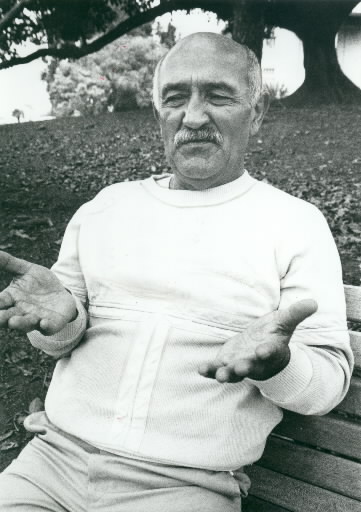1. ‘Atomic Kiwis’
Feb. 15, 2013
Chapter 3: The Central, South Pacific and Australia
Part 5: Victims of Christmas Island
Part 5: Victims of Christmas Island
During the 1950s Britain became the third power to develop a nuclear weapons capability after the United States and the Soviet Union. At five locations in Australia and the Christmas Island region, seventeen thousand British servicemen participated in a total of twenty-one atmospheric tests. Thirty years on, a disproportionately high incidence of cancer had been observed among these men, many of whose children were born with what are seen as genetic defects. A group of ex-servicemen formed the British Nuclear Tests Veterans Association, which has carried out surveys on radiation-linked diseases and begun procedures against the government in an effort to obtain compensation.
1. 'Atomic Kiwis'
Christmas Island was chosen as a test site in 1957, following growing criticism of the atomic bomb tests carried out on the Australian mainland. The British chose this island for its relative remoteness, the same reason the United States had used the Marshall Islands and France was to use the islands of Polynesia. In 1958 and 1959 Britain carried out six tests at Christmas Island and three at Morden Island, five hundred miles to the southeast.
Totaling almost six hundred in all, the New Zealand servicemen who took part in the British nuclear tests are known as "Atomic Kiwis." Their main duties were patrolling the test areas to ensure that no shipping strayed into them, and recording various meteorological data.
In New Zealand, we visited Turi Blake at his home in Wanganui, north of Wellington. For the past thirty years, he has held firm to the belief that during the 1950s he and his fellow servicemen in the New Zealand Navy were unwittingly involved in an experiment to test the effects on man of exposure to large doses of radiation.
On April 28, 1958, the warship on which Blake was serving lay at anchor twenty-five miles off Christmas Island in the Pacific. A British Royal Navy vessel, also in the area, had pulled back a much greater distance from the island and was a mere speck on the horizon. Twelve crew members on the New Zealand Navy ship including Blake were ordered up on deck. He and two others carried geiger counters around their necks; they wore no protective clothing, not even socks or gloves.
Following the captain's orders, they turned their backs, closed their eyes and waited for the explosion of the hydrogen bomb.
"The moment the bomb exploded, we were dazzled by a flash of light even though we had our eyes closed. Our backs felt as if they'd been set on fire."
When they turned round fourteen seconds later as ordered, the bright red fireball was changing to orange, and a huge mushroom cloud was rising up into the sky. There was a loud explosion and the men felt the shock waves wash over them as the ship was lashed by a blast of dusty wind and geiger counters shrieked angrily. The cloud proceeded to cover the sky completely and the men were drenched by heavy rainfall. The captain assured them there was nothing to be concerned about, but Blake began to suspect that he and his fellow crew members had been used as guinea pigs in an experiment.
Blake's sight deteriorated rapidly soon after leaving the navy in 1961. His mental state deteriorated as well, making it difficult for him to stay in work, and he now receives welfare benefits.
Dr. Graham Gulbransen, a member of IPPNW (International Physicians for the Prevention of Nuclear War), is an enthusiastic supporter of the Atomic Kiwis. Dr. Gulbransen has for some time been researching the medical histories of the fifty servicemen who have died since they participated in the tests in the late fifties.
According to his research, most of the servicemen died of cancer. Some of the men had actually shown symptoms of acute radiation sickness while they were on duty at the test sites. Gulbransen has come to the conclusion that even low doses of radiation may have detrimental effects on the health. The doctor has also noted a tendency toward psychological instability among the Atomic Kiwis, as in the case of Turi Blake.
The claims of the New Zealanders were investigated by the Ministry of Defense in an inquiry commissioned in 1987.
"Naturally, if it was found that our illnesses were caused by being used as guinea pigs, then we would demand compensation from the government," said Blake. "But more than that, we want them to release all the details of damage caused by the tests to the general public."








